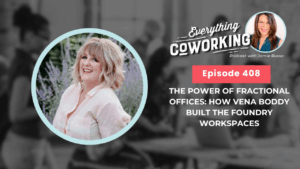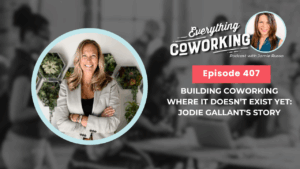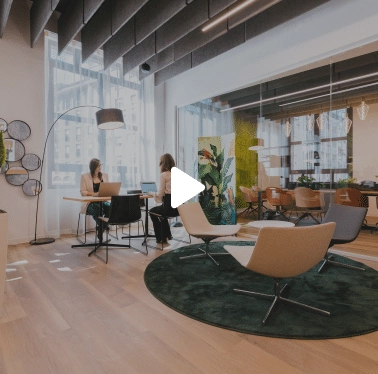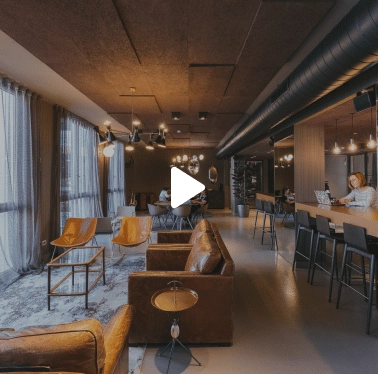
Customer LifeTime Value (CLTV) data is important to your business because you can use it to make profit-based decisions involving product mix, pricing, profit margin, and the services you offer.
CLTV metrics tell you how much a particular customer spends with you over their lifetime tenure as your customer.
This data helps you answer three important marketing questions:
- How much can I spend on sales and marketing?
- What can I double down on to attract my most profitable customers?
- What opportunities to increase CLTV can I find along my customer journey?
HOW DO YOU CALCULATE CUSTOMER LIFETIME VALUE?
The two primary components to CLTV in the coworking industry are:
1. monthly revenue
2. length of membership
Calculate CLTV by multiplying the monthly recurring revenue by the number of months a member stays with you. Calculate this number as an average across all of your members. It’s the average purchase value times the average number of purchases.
If you sell a la carte items, factor in total monthly revenue, not just recurring membership revenue.
The most useful data to help you make business decisions for your coworking space will be from the metrics based on membership type, such as private office, dedicated desks, and flex desks.
Pull the data to run this calculation from reports in your space management platform such as OfficeRnD, Proximity, or Satellite Deskworks.
HOW CAN YOU INCREASE THE DRIVERS OF CLTV IN YOUR COWORKING BUSINESS?
First: Create More PRODUCT with the highest CLTV. If you are starting a coworking space or looking to optimize your current business, one easy way to increase CLTV is to add more private offices. Since the two components of CLTV in a coworking business are monthly membership revenue and length of membership, your most profitable customers are likely to be private office members.
However, there is a trade-off to increasing private offices. Operators as well as members don’t necessarily want a private office “vibe” in their coworking space. On the other hand, offering a more collaborative, community atmosphere with amenities, open seating, and event space may attract and keep more members.
Another consideration is that offering only private offices requires more start-up capital to adequately equip them.
Let’s look at an example:
The average office member tenure is 12 months and has a monthly revenue of $1,000. The CLTV is $12,000.
The average flex desk membership tenure is 8 months and has a monthly revenue of $300. The CLTV is $2400. If you can “oversell” a flex desk, then your CLTV for that real estate might be 2x or $4800.
Therefore, the most profitable coworking spaces will have a product mix heavily weighted to private offices. Understanding your CLTV will help you make decisions about product mix.
Second: Find ways to increase the monthly revenue per customer. Optimize your captive audience by offering things that overlap with what they are already paying for.
In addition to the recurring membership fee, other drivers of revenue include:
- Mail fees
- VA Services
- Meeting room hours
- Vacation planning (this is a personal service request!)
- Phone answering
- Coaching
Third: Increase the lifetime of a customer by retaining that customer for as long as possible. If an office member stays for 16 months rather than 12 months, then your CLTV goes from $12,000 to $16,000. Since your acquisition cost of $500 stays the same, your profit goes up.
If you increase the office rate annually, your profit will go up even more when a member stays for more than 12 months. Add a cost of inflation increase each year.
HOW TO USE YOUR CLTV ANALYSIS TO MAKE THREE CRITICAL MARKETING DECISIONS IN YOUR COWORKING BUSINESS:
A. USE CLTV TO DETERMINE HOW MUCH YOU CAN SPEND ON SALES AND MARKETING OR CAC (CUSTOMER ACQUISITION COSTS).
If you have an office open that is priced at $1,000/month and your average office member stays for 12 months, the average CLTV for an office member is $12,000.
If you spend $500 in Google Ads to market your office to your next office member, your simple profit calculation is $12,000 – $500 = $11,500. That calculation is over-simplified. If you’re paying for an ads manager, paying a Community Manager or a sales manager for their time to manage leads, then there are more costs to consider in the profit calculation.
Quick side note: I think that a lot of operators resist running ads to acquire customers. They don’t budget for sales and marketing and think customer acquisition should essentially be free. If you build it, they will come.
Consider this: You have an office that’s open and it’s priced at $1,000. If you fill it through organic marketing in three months, your revenue in a 12 month period is $9,000. If you fill it through paid ads within one month, your revenue in a 12 month period is $11,000. If you spent $500 on ads, you actually lost $1500 by not running the ads.
Here’s the math on the example:
Organic leads = $0 cost and $9,000 revenue in 12 months = $9,000 profit.
Paid leads = $500 cost and $11,000 revenue in 12 months = $10,500 profit.
If you have multiple offices that are open, and you’re not running ads, in this example, you’re losing $1500 * the number of offices that you have open.
B. USE YOUR CLTV ANALYSIS TO DETERMINE WHAT TO DOUBLE DOWN ON IN ORDER TO ATTRACT CUSTOMERS WITH THE HIGHEST CLTV.
If CLTV in coworking is driven by monthly spend and membership tenure, then our best customers spend more and stay longer.
My most profitable customers are office members that place a premium on private space, have a great experience and stay a long time.
When it comes to lower-priced memberships such as flex desks and virtual office members, the key to increasing CLTV is to increase length of membership.
Since the office member equation is pretty straightforward, let’s look at the lower-priced open space (flex/hot desk) memberships. These have longer sales cycles, lower monthly revenue, and shorter tenure. If we can get these members to stay longer, then we increase their CLTV and have the challenge of replacing them less frequently.
Open desk members tend to convert more slowly because their need is not as urgent as it is for private office members. They need to be convinced to justify the expense.
Ask these questions to discover opportunities to attract and convert open space members to high CLTV customers:
- What is the profile of the open-desk member that stays the longest? Do they do a certain kind of work? Do they seem to have a common reason for joining the space?
- How does a long-term member behave? Do they attend member events? Do they get clients from other members? Do they mentor other members? Are they friends with other members? Do they have common interests?
- What lead sources deliver your best members? Ads? Location? Events? Referrals?
C. USE YOUR CLTV ANALYSIS TO DETERMINE WHAT TO DOUBLE DOWN ON IN ORDER TO ATTRACT CUSTOMERS WITH THE HIGHEST CLTV.
- Member onboarding
- Reaching out to members every 90 days to check in
- A relationship with your Community Manager
- Connecting with other members on a professional or personal level
- Attending relevant networking events that you host
- Making their life easier by adding services such as travel planning, dry cleaning pick-up service, etc.
Since the two components of CLTV in a coworking business are monthly membership revenue and length of membership, your most profitable customers are most likely private office members. Let’s look at an example:
The average office member tenure is 12 months and has a monthly revenue of $1,000. The CLTV is $12,000.
The average flex desk membership tenure is 8 months and has a monthly revenue of $300. The CLTV is $2400. If you can “oversell” a flex desk, then your CLTV for that real estate might be 2x or $4800.
There are reasons unrelated to CLTV to have flex desks, but the most profitable coworking spaces will have a product mix heavily weighted to private offices.
DO YOU NEED MORE HELP MEASURING AND OPTIMIZING CLTV IN YOUR BUSINESS?
We’d love to know how CLTV data is impacting your business. Here’s how you let us know:
Post in the Everything Coworking Facebook Group
Or
Book a call to learn more about our mentor program.
Have you listened to my podcast episode, Three Decisions a Coworking Operator Can Make with Customer Lifetime Value Data? Have a listen here!







